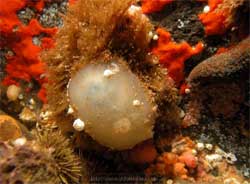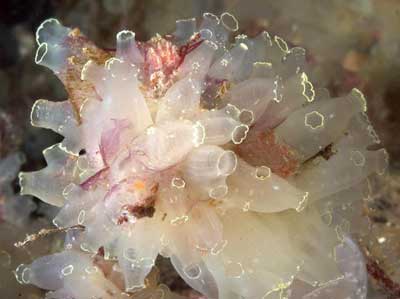Ascidiacea - Ascidiacea
Berries are animals that look like plants, distributed throughout the oceans: From the tidal inundation (brackish water) to the deep sea, thousands of meters are visible. The berries are clinging to the dense crust, affecting the speed of running the train, consuming fuel, it clings to the underground pipe to block the pipe. But the tail of young pepper

(Photo: guiamarina)
there is a spine, a sign of high-level animals, people are listed in the vertebrate. Customs have an important effect in studying vertebrate origins in evolution.
The shape of a pepper is like a tomato, sometimes like a flower, which looks very much like a tea kettle. If you poke it with your finger, it will spew a very strong water flow, then slowly stand upright, it is softly drooping like cotton.
The pepper is an animal that lives in place, the outer shell encapsulates a Cellulose shell that protects and mold shapes. This is the only phenomenon of the animal world. So called a pepper (pepper is a shell). Thanks to the water inlet and outlet pipes to absorb oxygen, through the intestine to absorb nutrients and small organisms in the water.
There are sea lilies when spawning from the body growing out of a preschool , this germ grows up and leaves the mother's body to develop into a new body. That is the real germ of the pepper. There are marine species that reproduce sexually , then, bisexual pepper, eggs and sperm are not mature and cannot be self-consumed, must "go back" to other customs.
Young sea lilies are very similar to tadpoles, eyes, brain and tail are very developed, there is a spine in the middle. The back of the spinal cord has a neural tube that goes straight to the end of the body, the gills of the gills and the young pepper can freely swim. After a few hours, the tip of the new body gradually protrudes into other objects. Then the tail wilted, then completely lost, eventually keeping only one neuron.The metamorphosis from small to big of the sea is contrary to the evolutionary way so zoology is called reverse metamorphosis.

(Photo: seawater)
- Sustainable agriculture model for alkaline soils
- Super NASA computers simulate a whirlwind from a drone plane
- Symbian encourages cheap 3G services
- This invention can eliminate complications in cosmetic and medical surgery
- Arsenic can be fatal after 20 years
- Students make instant hemostatic substances
- Normal indicators when evaluating a semen test
- Free gifts from NASA
- Beams of lemurs 'ballet, hip hop dance'
- Tomorrow, the North is very cold, with hail
- Shouting sharks 'hunting' plastic waste
- Crows hold secrets about aliens?
 Surprised: Fish that live in the dark ocean still see colors
Surprised: Fish that live in the dark ocean still see colors Japan suddenly caught the creature that caused the earthquake in the legend
Japan suddenly caught the creature that caused the earthquake in the legend A series of gray whale carcasses washed ashore on California's coast
A series of gray whale carcasses washed ashore on California's coast Compare the size of shark species in the world
Compare the size of shark species in the world Unexpected effects when you sprinkle pepper on food
Unexpected effects when you sprinkle pepper on food  A new type of chili sets the world's spiciest record
A new type of chili sets the world's spiciest record  The tiny seeds available in this kitchen can be used to make great winter medicine
The tiny seeds available in this kitchen can be used to make great winter medicine  Raising puberty of the pepper species: When I was young, it was very beautiful, growing up ugly and turning on my brain
Raising puberty of the pepper species: When I was young, it was very beautiful, growing up ugly and turning on my brain  Taste of pepper 13,000 years
Taste of pepper 13,000 years  The chilli is so hot that it only bites 1 shot, this will be your last meal
The chilli is so hot that it only bites 1 shot, this will be your last meal 